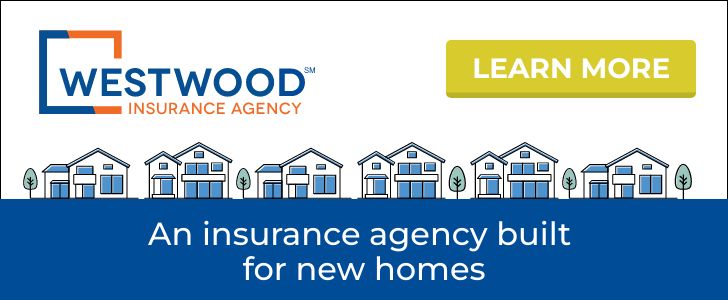Leadership
Spring Selling's Key Monthly Payments Challenge: PITI Math
Homebuilders rely on partners to assist them with that customer journey and customer experience so that they know that they’re protected. And, there’s peace of mind that comes with it.

Monthly payment math. Practically everybody's doing it, and virtually nobody needs to wonder why.
These days, payment power – notably, a sum total of principal, interest, taxes, and insurance as a function of net household income – is a constantly moving target. Once a domain entry-level and first time buyers cared most about, monthly payments – since inflation and soaring mortgage interest rates started eroding households' payment power – have become a thicker, higher wall of worry for more would-be homebuyers across income ranges and market segments.
The squeeze on consumers from all sides is real, and adding up.
That extra money people were able to save during the pandemic is dwindling. Household debt is up. Delinquency rates on credit cards and auto loans are still below where they were before the pandemic, but they’re starting to creep back up, and it appears younger borrowers, in particular, are struggling. The amount of disposable income people will need to pay their debts is “likely to surpass and remain much higher than pre-pandemic levels — representing a real financial strain on households and consumer spending capacity,” wrote Greg Daco, chief economist at EY-Parthenon, in market commentary on February 22." Emily Stewart, Vox

For a solid two years following the Covid convulsion in Spring 2020, it was the "P" in PITI that was the line-item on the move, spiralling upward. For the past eight months or more, it's the "I" for interest that has spooled up, pricing out millions and putting even more prospective homebuyers on a bubble of uncertainty, both on the loan-to-income qualification front and on the monthly payments end.
In late November and December, interest rates relented a bit, dropping well below 6% for a fixed-rate 30-year conventional mortgage. Buyers in droves suddenly reawakened and activated, fueling solid late December, January, and February sales pace in many markets, and tamping down order cancelations.
Still, as mortgage rates suddenly begin to retrace upward, and look as if they could spike even higher, that monthly payment math – on both homebuilders' parts and among prospective homebuyer households – has become a white-knuckle exercise. This is especially so among would-be homebuyers for whom making ends meet has become a tougher feat to pull off as high prices stay sticky, or even glide upward even as the economy shows signs of strain.
There's pressure among builders -- once they've completed vertical construction of a home, it becomes a liability – and they want to turn it fast," says Tom Kriby, Vice President, Client Development and Partnerships at Westwood Insurance Agency. "When shifting market conditions come along, and there’s either price increases -- or like we’ve seen – rate increases. They were trending in the proper direction the last couple of months and this past week, they’re back up over 7% – it really comes down to what you can afford on a monthly basis for that customer. A lot of the builders are selling to a monthly payment, and not a home price. And they’re trying to work as much as they can with rate buydowns.
Still, most everybody forgets about insurance, because there’s so many of these expenses that are being added in that insurance is one of those last things that anybody thinks of. But in difficult, strenuous markets like a Florida, Texas, or even a California – the three largest markets for builders – insurance can sometimes derail those closing processes."
Kriby explains that a partner like Westwood can drive benefit for a builder because it accomplishes and locks down the underwriting process upfront, before any customers walk through a door into a sales office, or a model, or to sign a purchase agreement. Underwriting on that property – presale – sets itself in stone. This way, if a customer decides, ‘Yes, I am buying this house in four months' time or in eight months’ time,’ the customer can see insurance rates already in place. This way, that loan officer can plug that in to their debt-to-income ratio and they know where those ratios sit.
An independent insurance agency, Westwood's network of 40 carriers operate in all markets in 50 states, Kriby notes. Carriers in Florida underwrite to significantly different criteria than the carriers that in California, or Idaho, or Utah, or Michigan. So, Westwood sources competitive rates nationwide.
We’ve got the best rate upfront so that everybody, from the builder, to the loan officer, to the customer knows that, once they get to closing that insurance process is done, and insurance will never be the reason for delaying a closing, Kriby says. "That’s the goal. We never want to cause any issues on that builder’s house. They want to transact that product and get that inventory turn the moment they can without a hitch."
Partner CX
Consumer experience guru and author Joseph Michelli names four non-negotiables for service excellence as a partner, and it applies for partners engaged with consumer households worrying and working through those line-items on monthly payments math:
- Relevance: to what degree do you give customers what they say they want.
- Ease and consistency: How well do you provide reliable products and frictionless service the first time, every time, and across all channels.
- Speed: How well do you respect your customers' time?
- Security: To what degree do you protect your customer's health, privacy and data?
When it comes to the Insurance line-item in both homebuilders' and homebuyer prospects' monthly payments calculus, Michelli's non-negotiables resonate.
With a PITI calculation, insurance is last and always most boring to think about," says Westwood's Kriby. "People usually forget about it until they need it. That’s really the importance of insurance. You don’t want to have to ever think about it. But, if something bad happens, you want to be able to know that you’ve got an agent who’s there to assist. With pandemic and people working from their home, living at home, a lot of extra touch points, and people not leaving for work realized they had valuables they wanted to protect. It doesn’t really matter where they were living, because we have a presence in all 50 states."
We can offer solutions anywhere. But a majority of people were leaving New York, or San Francisco Bay Area, and relocating to more warm weather climates. And that’s really where most of the construction has been anyway. Phoenix, Dallas, Houston, Tampa, Miami … that’s where a lot of the relocation was, and that’s where our best markets are. They were building larger homes because people now want a home office. Tying it back to insurance world, we have solutions for builders and whatever product they want to build… whether it’s an entry level home, or they want to build an entertainment house or even a luxury house, we do have those products. Again, we don’t want to make insurance upfront and in your face, we want it to be back-of-mind. That’s where the builder relies on us to assist them with that customer journey and customer experience so that they know that they’re protected and there’s that peace of mind that comes with it."
Particularly in a moment like now – kicking off a the critical Spring Selling season, and trying to bring a full set of tools to the job of making builders' monthly payments math match up to the line-item arithmetic going on at the kitchen table -- every dollar counts.
The next 12 months really are a challenge for the builders to make sure they’re building the right product and they rely on us to provide an insurance policy for an amount at a competitive rate regardless of what they are building and selling," says Westwood's Kriby. "We’re there for them and we want to make sure that their customers see a quote as much as possible. The goal is to have 100% of their customers see a quote from us. We believe that their customers will see significant savings from what they would find in the regular insurance agent marketplace. The more customers who see our quote, the more dollars they’ll save on the back end. It makes for a better experience for everybody."
MORE IN Leadership
10 Bold Ideas Tackling Housing Affordability And Access Now
From AI to hempcrete, these 10 ideas show how innovation in design, finance, and policy can open the door to housing affordability.
Sumitomo Forestry Sharpens U.S. Focus With DRB Move
Strategic clarity replaces portfolio sprawl as Sumitomo bets big on U.S. scale and integration.
Homebuilders and Insurance: A New-Reality Cost To Stay Ahead
Exclusive insights from Westwood Insurance Agency’s Alan Umaly and MSI’s Naimish Patel reveal why homebuilders must rethink insurance, resilience, and risk management—or risk losing buyers in an increasingly volatile market.


